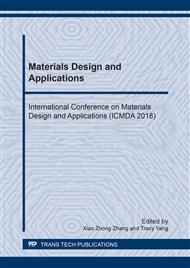[1]
T. Ramasami, S .Rajamani and J. Raghavarao: Pollution control in leather industry: Emerging technological options. International symposium on surface and colloidal science and its relevance to soil pollution, madras (1994).
Google Scholar
[2]
M. A. A. Jahan, N. Akhtar, N.M.S. Khan, C.K. Roy, R. Islam and M. Nurunnabi: Characterization of tannery wastewater and its treatment by aquatic macrophytes and algae. Bangladesh Journal of Scientific and Industrial Research, Vol 49, No 4 (2014).
DOI: 10.3329/bjsir.v49i4.22626
Google Scholar
[3]
B.I. Islam, A.E. Musa, E.H. Ibrahim, S.A.A. Sharafa and B.M. Elfak: Evaluation and Characterization of Tannery Wastewater. Journal of Forest Products & Industries 2014, 3(3), 141-150 Issn: 2325–4513 (2014).
Google Scholar
[4]
S.L. Sultana, S. Mahmud and T. Manzur: Review On Possible Detrimental Effects Of Tannery Wastewater Constituents On Concrete , First International Conference on Advances in Civil Infrastructure and Construction Materials, CICM, MIST, Dhaka, Bangladesh (2015).
Google Scholar
[5]
S. Samad and A. Shah: Review Article Role of binary cement including Supplementary Cementitious Material (SCM), in production of environmentally sustainable concrete. International Journal of Sustainable Built Environment 6, 663–674, (2017).
DOI: 10.1016/j.ijsbe.2017.07.003
Google Scholar
[6]
R. P. Khatri, V. Sirivivatnanon, W. Gross: Effect of different supplementary cementitious materials on mechanical properties of high performance concrete. Cement and Concrete Research, Volume 25, Issue 1, Pages 209-220 (January 1995).
DOI: 10.1016/0008-8846(94)00128-l
Google Scholar
[7]
R. N. Swam: Role of slag in the development of durable and sustainable high strength concretes. Proceedings of International Symposium on concrete technology for sustainable development in the 21st Century. Hyderabad, p.186–121 (1999).
DOI: 10.1201/9781482272215-13
Google Scholar
[8]
S. Mahmud and S.L. Sultana: Effects of Tannery Wastewater Constituents on Cement Composites. B.Sc Thesis, Department of Civil Engineering, Bangladesh University of Engineering and Technology(BUET), Dhaka, Bangladesh (2016).
DOI: 10.21474/ijar01/8834
Google Scholar
[9]
Information on https://en.wikipedia.org/wiki/Fly_ash.
Google Scholar
[10]
Information on https://en.wikipedia.org/wiki/Slag.
Google Scholar
[11]
S. Saha and S.A. Papry: Assessment of Cement Mortar Degradation when Exposed to Tannery Wastewater, B.Sc Thesis, Department of Civil Engineering, Bangladesh University of Engineering and Technology(BUET),Dhaka, Bangladesh (2016).
DOI: 10.31254/jsir.2017.6403
Google Scholar
[12]
ASTM C109/ C109M. Standard Test Method for Compressive Strength of Hydraulic Cement Mortars (Using 2-in. or [50-mm] Cube Specimens), ASTM International, West Conshohocken, PA (2008).
DOI: 10.1520/c0109_c0109m-13
Google Scholar
[13]
Nisbet, M.A., Marceau, M.L., and VanGeem, M.G: Life Cycle Inventory of the Cement Manufacturing Process, PCA R&D Serial No. 2095a, Portland Cement Association, Skokie IL, PCA, (2002).
Google Scholar
[14]
A. Samarin: Wastes in Concrete :Converting Liabilities into Assests, in Ravindra K. Dhir, Trevor G. Jappy, Exploiting wastes in concrete: proceedings of the international seminar held at the University of Dundee, Scotland, UK, Thomas Telford, p.8 (1999).
DOI: 10.1680/ewic.28210
Google Scholar


